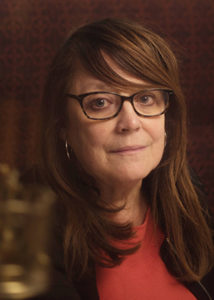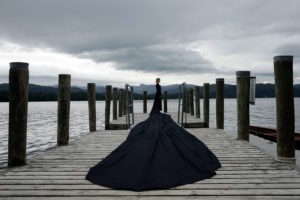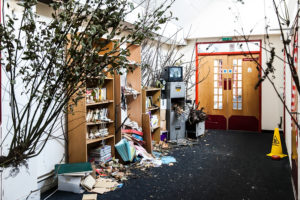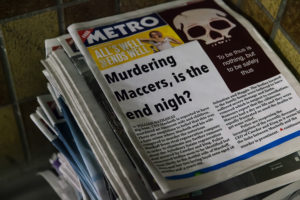"I want to acknowledge the existence of these buildings that are often lying empty and derelict and unloved" - Q&A with Geraldine Pilgrim
 Geraldine Pilgrim is Head of Site-Specific Theatre Practice, and a director/designer and installation artist working across theatre and the visual arts. As Artistic Director of Geraldine Pilgrim Performance Company she creates evocative installations and site-specific performances that encourage a contemporary dialogue with historic houses, buildings and landscapes both in the UK and across Europe, often working in collaboration with young people, older people and arts and community groups.
Geraldine Pilgrim is Head of Site-Specific Theatre Practice, and a director/designer and installation artist working across theatre and the visual arts. As Artistic Director of Geraldine Pilgrim Performance Company she creates evocative installations and site-specific performances that encourage a contemporary dialogue with historic houses, buildings and landscapes both in the UK and across Europe, often working in collaboration with young people, older people and arts and community groups.
Site-specific theatre is a fast-growing art form that has captured the imagination of theatre and fine art practitioners around the world. True site-specific theatre engages with a chosen site’s history, atmosphere and architecture to underpin devised or text-based narratives. Site-specific theatre is an art form in its own right, allowing a space to inform the final performance and acknowledging that the performance can only happen in the specific site.
“For me site-specific work is like peeling away different layers of wallpaper to release the ghost of a building or landscape’s past, whilst being aware of its present condition and dreaming of its future.”
We spoke to Geraldine about her work and Mountview’s MA Site-Specific Theatre Practice.
Can you tell us briefly about the MA?
The Mountview Site- Specific Theatre Practice MA is unique, through not only being the first of its kind in the UK but also innovative for being in partnership with Shoreditch Town Hall. It’s a one-year full time practical-taught MA over three terms and consists of a variety of salons, seminars and Master classes as well as site visits, practical exercises and a site residency in Italy. The MA is based at Shoreditch Town Hall where the students have their own self contained studio space whilst also having all the facilities of the new purpose built Mountview Peckham site as well. It’s aimed at practitioners and graduates with a fine art, live art or theatre background wanting to diversify their artistic skills in the areas of site- specific practice.
“This MA is for new generations of site-specific theatre makers to create their own language and take it forward into the future.”
What inspired you to start creating site-specific work?
I originally trained as a Fine Artist and co-founded the touring Visual Theatre Company “Hesitate and Demonstrate” which toured main stage and studio theatres in the UK and Europe. To me, theatres are empty neutral spaces waiting to be filled with people’s imaginations and after the end of the Company, I found myself instinctively working in a new direction, creating performances in spaces and places which already had a memory and where the architecture of the site is used as inspiration and narrative, gradually revealing atmospheres and memories that have built up over the years, together with the history – imagined and real – of the space.

For me, site-specific work is like peeling away different layers of wallpaper to release the ghost of a building or landscape’s past, whilst being aware of its present condition and dreaming of its future. I want to acknowledge the existence of these buildings that are often lying empty and derelict and unloved. I now work across both theatre and the visual arts; creating a contemporary dialogue with occupied and deserted buildings, historic houses and landscapes often working in collaboration with young people, older people and arts and community groups. My performances and installations in the UK and mainland Europe have taken place in empty and occupied office blocks, schools, hotels, swimming pools, factories and hospitals as well as castles, stately homes and public parks. I love transforming spaces and places and bringing out the atmosphere of a space through performance to audiences that often don’t go to theatres but love the opportunity to experience a building or landscape – often in a transitionary phase before re-development or demolition – being brought back to life even if it is only for one day.
What excites you most about the course being based in Shoreditch Town Hall?
Shoreditch Town Hall is a stunning, evocative building with its different forms of architecture, fascinating history and use, including not only having been a Town Hall until the 1960s but also an intrinsic part of the East End Community. It was then saved from neglect and dereliction by the community to become this inspiring independent arts centre, experienced in presenting site – specific theatre. To me, it is a space that is now respected and loved, the atmosphere and its history remain embedded in the building and yet it is cleverly equipped to present and commission many different styles of theatre. The students have the wonderful opportunity to see all the performances that happen not only in Mountview but also in the many different spaces of Shoreditch Town Hall and be part of two vibrant communities, Peckham and Shoreditch.

How do you think site-specific work has evolved and what do you anticipate for its future?
The doors of traditional main stage and studio theatres have been swung open to allow a rush of fresh air by creating performances in non-theatrical spaces that inspire the work itself. The art form is now established as a practice and there are performances that happen all over the UK by emerging and established companies and artists. It is a constantly changing and developing form with each practitioner and company having their own way they respond to site. This MA is for new generations of site-specific theatre makers to create their own language and take it forward into the future.
Photos by Katherine Leedale, Sheila Burnett and Lyodd Winters.

